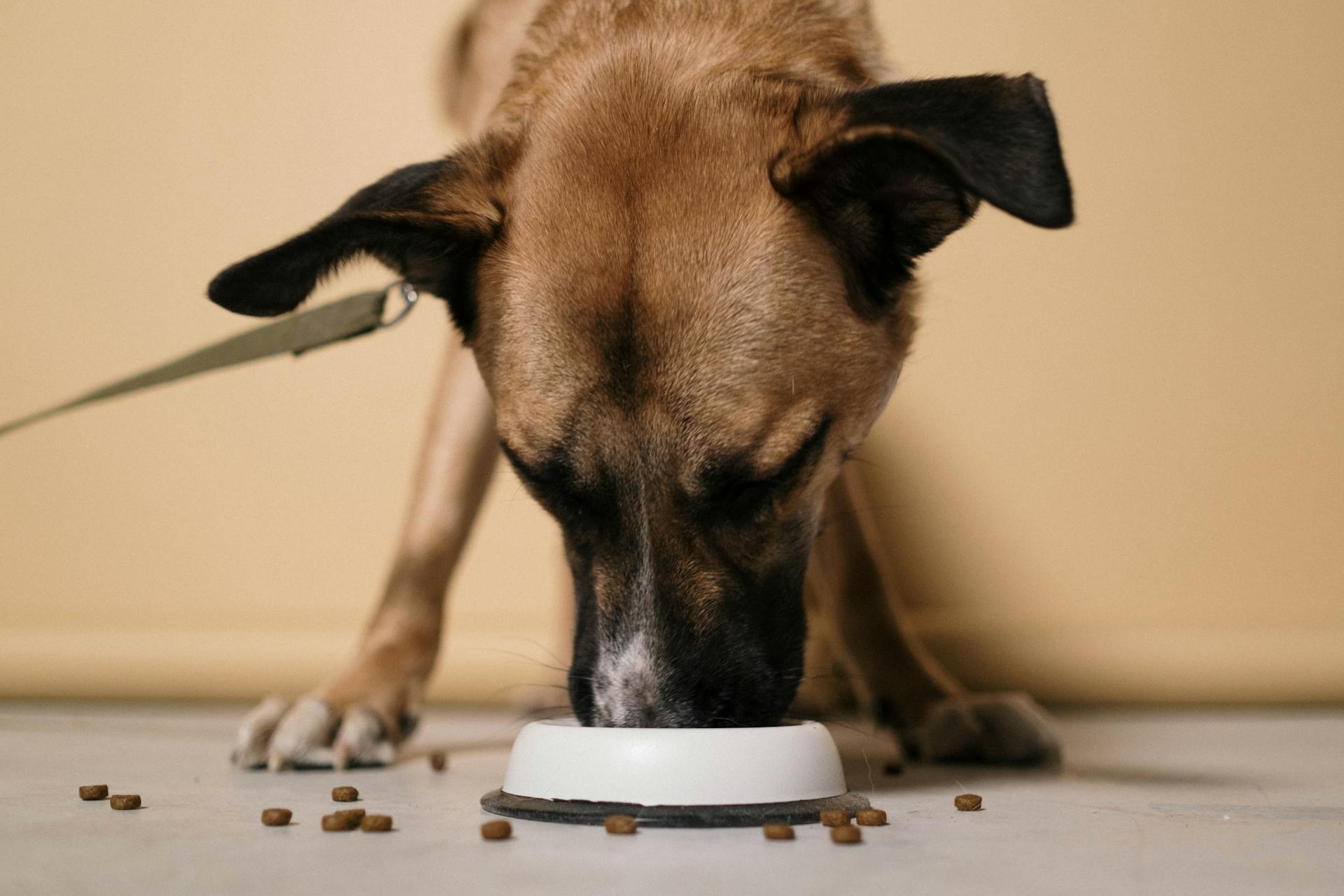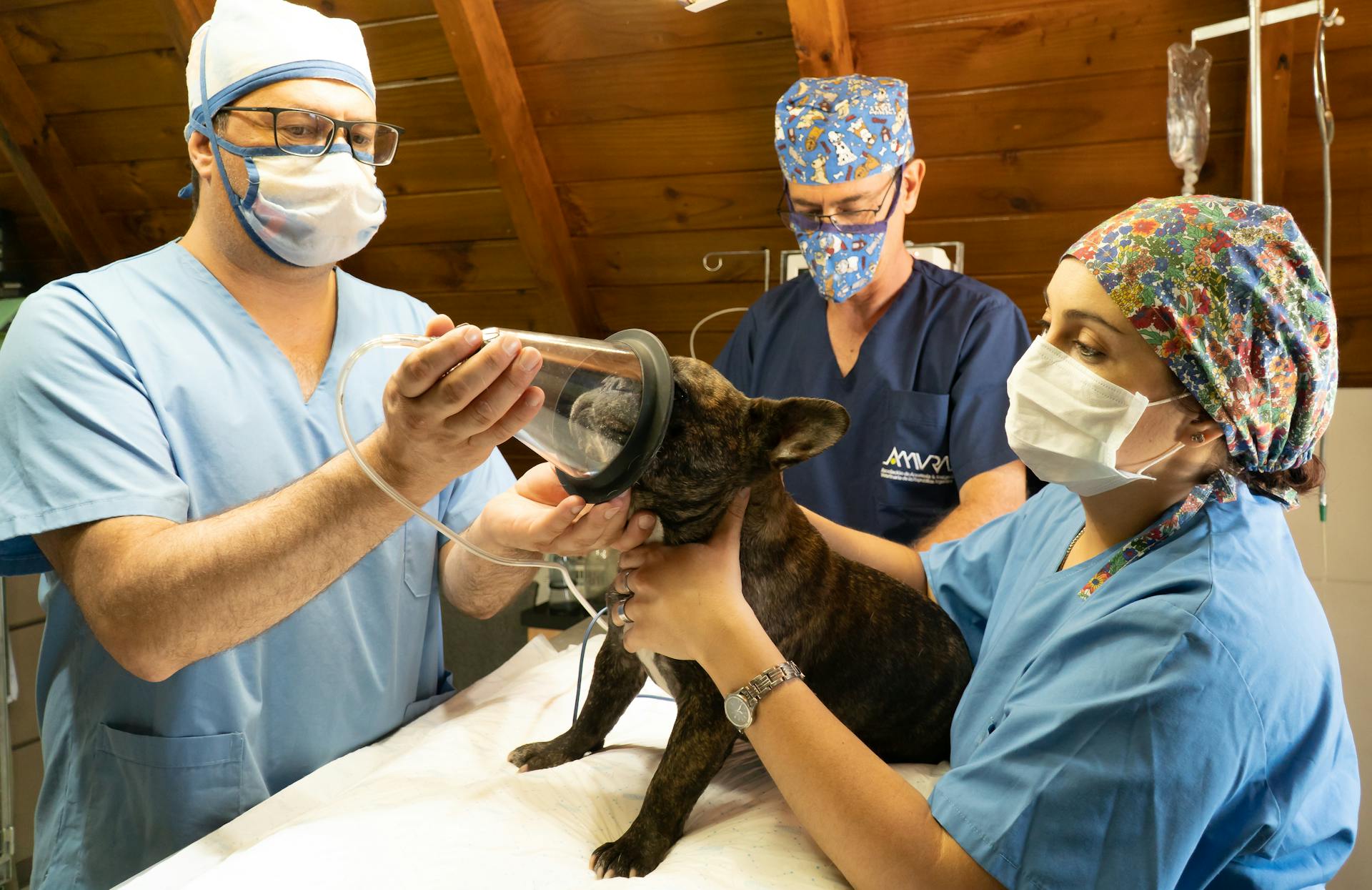
Canine food bloat is a serious condition that can happen to any dog, regardless of age or size. It occurs when a dog eats too quickly or swallows air, leading to a buildup of gas in the stomach.
This buildup can cause the stomach to expand, putting pressure on the diaphragm and making it difficult for the dog to breathe. In severe cases, the stomach can rupture, leading to life-threatening complications.
The symptoms of canine food bloat can be subtle at first, but they can quickly become severe. A dog may exhibit signs such as vomiting, restlessness, and a distended abdomen.
If left untreated, canine food bloat can be fatal, so it's essential to recognize the warning signs and seek veterinary attention immediately.
Causes of Canine Food Bloat
Canine food bloat is a serious condition that can be caused by various factors. Overeating is a common culprit, as it can lead to a buildup of gas in the stomach.
Some dogs may have food sensitivities or allergies that can cause bloating. If a dog is allergic to a certain food, their body may react by producing excess gas.
Certain breeds are more prone to food bloat due to their anatomy. Large breed dogs with deep chests, such as Great Danes, are 5 to 8 times more likely to bloat than dogs with a low height to width ratio.
Risk factors for food bloat include eating very quickly, overeating, drinking a large quantity of water in a short period of time, and exercising after eating. These factors can increase the likelihood of stomach dilation and volvulus.
Here are some common causes of canine food bloat:
- Eating very quickly
- Overeating
- Drinking a large quantity of water in a short period of time
- Exercising after eating
Swallowing Air
Dogs can inhale air while eating or drinking, leading to a bloated belly. This can happen when they eat quickly, gulping down their food in a hurry.
Eating rapidly can cause a dog to swallow air, which can then accumulate in their stomach. This is a common issue in dogs that gobble their food down quickly.
Swallowing air while drinking water is also a contributing factor to bloating. Dogs that drink large amounts of water at once are more likely to inhale air, which can then cause discomfort and bloating.
Expand your knowledge: Should I Put Water in My Dogs Food
Causes of GDV
GDV, or gastric dilatation-volvulus, is a serious condition that can cause a dog's stomach to twist, cutting off blood flow and potentially leading to death. The exact cause of GDV is still unknown, but certain risk factors have been identified.
Large, deep-chested male dogs are more prone to GDV, with Great Danes being 5 to 8 times more likely to bloat than dogs with a low height to width ratio. This is likely due to their unique body shape, which can lead to stomach twisting.
Eating very quickly, overeating, and drinking a large quantity of water in a short period of time can all contribute to GDV. This is because these actions can cause the stomach to fill too quickly, leading to twisting and cutting off blood flow.
Exercise after eating is another risk factor, as it can cause the stomach to move and twist. Stress and anxiety can also play a role, with anxious dogs being more prone to GDV.
Take a look at this: Can Too Much Water Cause Diarrhea in Dogs
Here are some specific risk factors associated with GDV:
- Eating very quickly
- Overeating
- Drinking a large quantity of water in a short period of time
- Exercising after eating
- Raised food bowls
- Stress (anxious dogs are thought to be more prone)
- Genetic factors
- Increased age
It's worth noting that some studies have suggested that feeding a dry food with fat or oil listed in the first four ingredients may also increase the risk of GDV. On the other hand, feeding a dry food containing a calcium-rich meat meal listed in the first four ingredients may actually reduce the risk.
Discover more: Soften Dry Dog Food
Symptoms and Signs
Symptoms of canine food bloat can be subtle, but it's essential to recognize them early on. A swollen or distended belly is a common sign, and it can be accompanied by vomiting.
If your dog is experiencing vomiting, it's a clear indication that something is amiss. Difficulty breathing, lethargy, and loss of appetite are also red flags. Abdominal pain and restlessness are other symptoms to look out for.
Here are some key signs to watch out for:
- Restlessness and pacing
- Swollen or distended abdomen
- Painful abdomen
- Excessive drooling and panting
- Rapid breathing and collapse
These signs can progress quickly, so it's crucial to seek veterinary attention if you notice any of them. Early detection and treatment can make all the difference in preventing the condition from becoming severe and even life-threatening.
Dog Belly Swelling Symptoms
Dog belly swelling symptoms can be a serious concern for pet owners. A swollen or distended belly is one of the most common signs of a bloated belly in dogs.
Vomiting is another symptom that may occur, and it's essential to note that not all vomiting is the same - some dogs may try to vomit but be unable to do so.
Difficulty breathing, lethargy, loss of appetite, abdominal pain, and restlessness are all potential symptoms of a bloated belly in dogs.
Here's a list of common symptoms to look out for:
- Swollen or distended belly
- Vomiting
- Difficulty breathing
- Lethargy
- Loss of appetite
- Abdominal pain
- Restlessness
- Rapid heartbeat
- Excessive drooling
- Panting or rapid breathing
- Collapse/inability to stand
- Swollen or distended abdomen
- Painful abdomen
- Overall look of distress
- Restlessness
- Pacing
- Retching or attempts to vomit with no success
Early detection and treatment are crucial in preventing the condition from becoming severe and even life-threatening.
Physical Examination
A physical examination by a veterinarian is a crucial step in evaluating the severity of a bloated belly in dogs. They will check for any other symptoms or underlying health issues.
The veterinarian will physically examine your dog to evaluate the severity of the bloating. This examination can help identify any underlying causes or complications.

Some common signs of a bloated belly in dogs include a swollen or distended belly, vomiting, difficulty breathing, and lethargy. Your veterinarian will look for these signs during the physical examination.
The veterinarian may also check for abdominal pain, restlessness, and a rapid heartbeat. These symptoms can indicate a more severe case of bloated belly.
Here are some common signs of a bloated belly in dogs that a veterinarian may look for during a physical examination:
- Swollen or distended belly
- Vomiting
- Difficulty breathing
- Lethargy
- Abdominal pain
- Restlessness
- Rapid heartbeat
Treatment and Prevention
If your dog is experiencing canine food bloat, it's a life-threatening emergency that requires immediate veterinary intervention. This means you should seek help right away.
A veterinarian may try to pass a stomach tube to relieve pressure, or insert a large bore needle or catheter into the stomach to decompress it. Shock treatment with IV fluids and emergency medications must begin immediately.
Preventing bloat is crucial, and one of the most effective methods is a gastropexy, a surgical attachment of the stomach to the body wall. This can be done at the time of spay or neuter, or on its own, and it can prevent twisting (volvulus) in most cases.
To reduce the risk of bloat, you can also try feeding smaller meals more frequently, restricting activity for 1-2 hours after meal time, and avoiding strenuous exercise on a full stomach.
Preventing the Condition

Gastropexy, a surgical attachment of the stomach to the body wall, is the most effective means of prevention, especially in high-risk breeds. It prevents twisting (volvulus) in most cases.
Careful attention to diet, feeding, and exercise regimens can also help prevent gastric dilatation. Feeding smaller meals more frequently, and restricting activity for 1-2 hours after meal time, can make a big difference.
Do not use a raised food bowl, as this can contribute to bloat. Similarly, avoid letting your dog drink a large amount of water all at once.
A gastropexy will help stop the stomach from twisting if bloat occurs 95% of the time. Many owners of large breeds of dogs opt to have the surgery done when their dogs are young.
Here are some strategies to reduce the risk of bloat:
- Feed smaller meals more frequently
- Restrict activity for 1-2 hours after meal time
- Do not use a raised food bowl
- Avoid letting your dog drink a large amount of water all at once
- Avoid strenuous exercise on a full stomach
While these measures can help reduce the risk of bloat, they do not guarantee that your dog won't bloat. However, they may help lessen the severity of the problem if it arises.
See what others are reading: Bloat Sleep
Treatment Options for GDV
Treatment Options for GDV are critical and time-sensitive. Immediate veterinary intervention is required to reduce the pressure on the stomach wall and internal organs.
A stomach tube may be attempted to relieve pressure, but if twisting of the stomach occurs, a large bore needle or catheter may be inserted through the skin into the stomach to release pressure.
Shock treatment must begin immediately, using intravenous fluids and emergency medications to stabilize the patient.
Surgical correction of the GDV is necessary, but it may be delayed until the patient is stable enough to undergo anesthesia.
Preventative measures can be taken to reduce the risk of bloat, such as feeding smaller meals more frequently, restricting activity after meal time, and avoiding strenuous exercise on a full stomach.
A gastropexy, a procedure that sutures the stomach to the abdominal wall, can be performed to prevent twisting of the stomach and is 95% effective in preventing recurrence.
Expand your knowledge: Canine Stomach Anatomy
Surgery may also be necessary to untwist the stomach or remove an obstructing object in severe cases of GDV or intestinal obstruction.
Here are some key steps a vet may take in an emergency bloating episode:
- Reduce pressure on the stomach wall and internal organs
- Administer shock treatment with intravenous fluids and emergency medications
- Perform surgical correction of the GDV, if necessary
In extreme cases where the condition has been left untreated for a longer time period, there may be too little live tissue to salvage, and the prognosis becomes grave.
Sources
- https://embassylakesanimalhospital.com/blog/dog-bloat/
- https://vcahospitals.com/know-your-pet/bloat-gastric-dilatation-and-volvulus-in-dogs
- https://vmccny.com/gastric-dilatationvolvulus-bloat/
- https://www.mcahonline.com/canine-bloating-gastric-dilatation-and-volvulus-gdv-in-dogs/
- https://www.marylandpetemergency.com/canine-bloat-gdv.html
Featured Images: pexels.com

